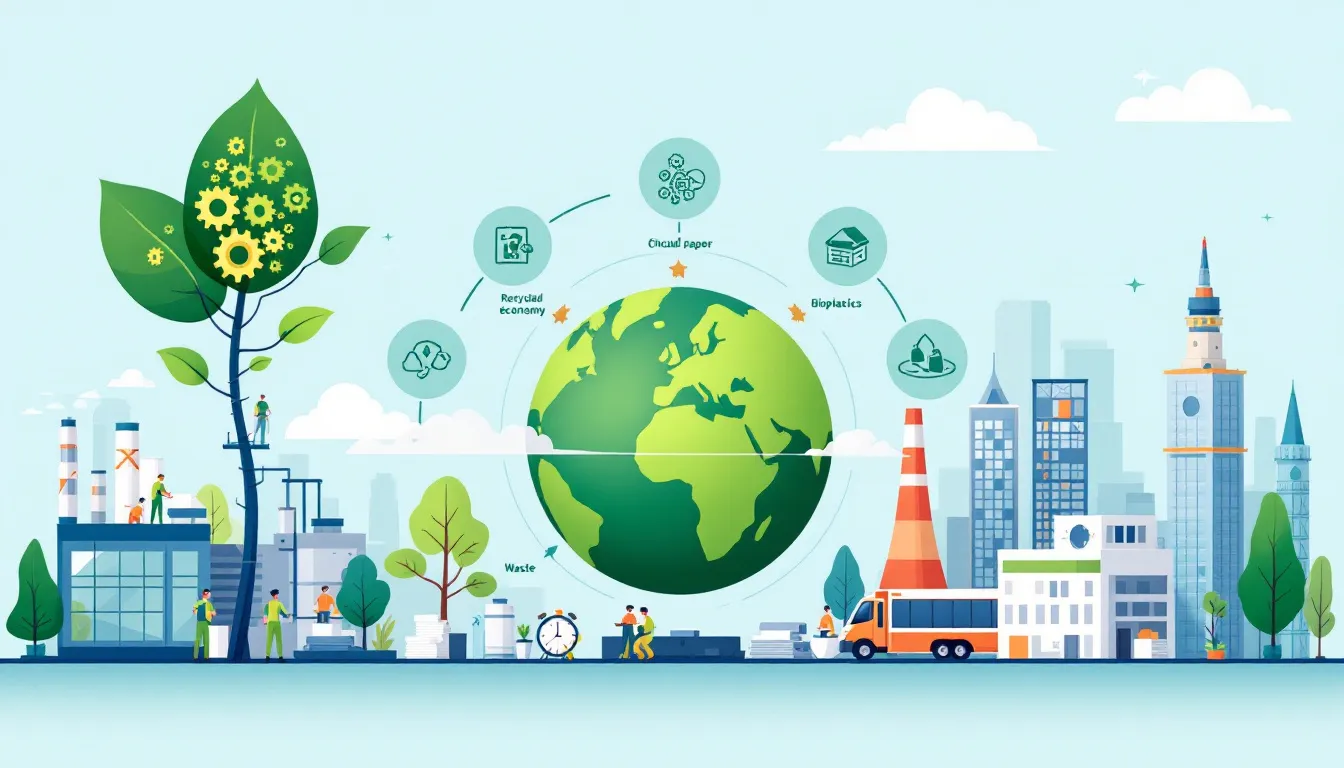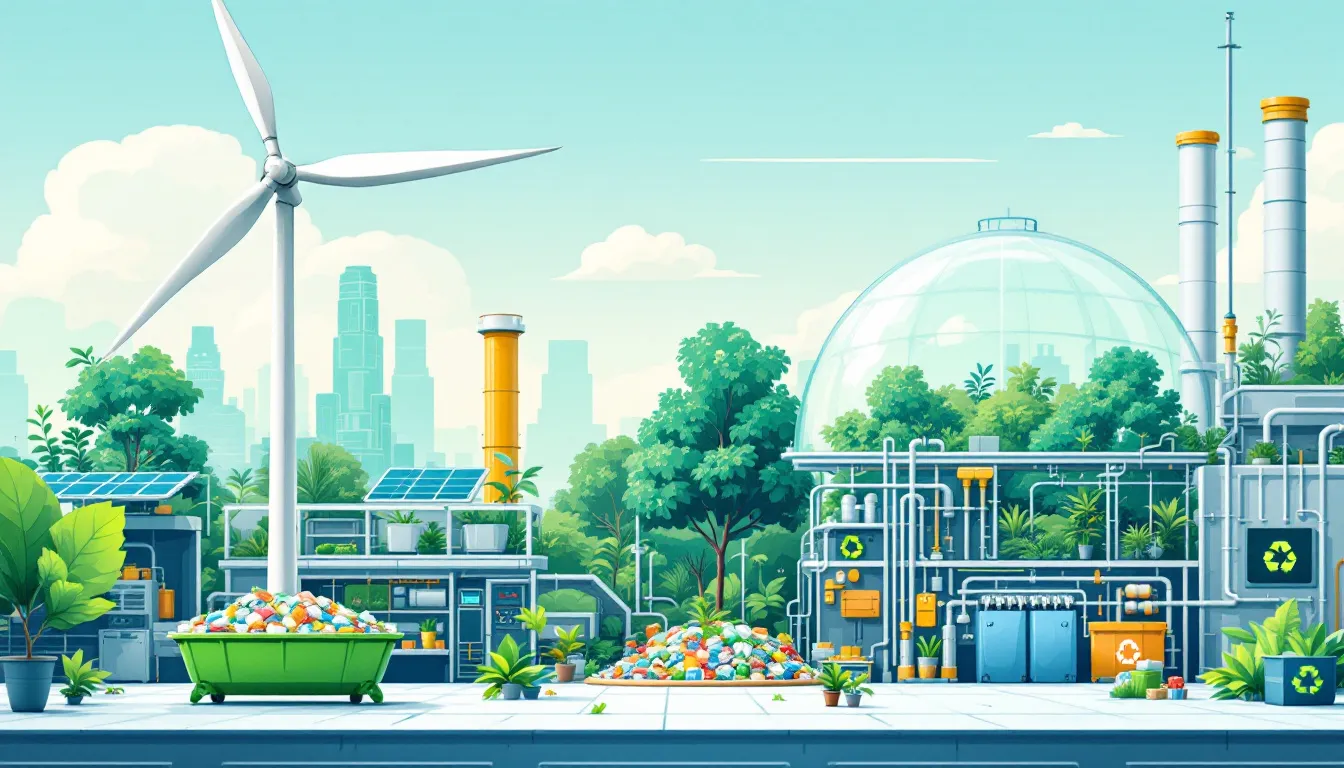Green manufacturing means producing goods sustainably by minimizing pollution and waste. This article details its benefits, essential practices, and how businesses can adopt it.
Key Takeaways
-
Green manufacturing integrates sustainable practices to minimize pollution and resource usage, enhancing both environmental stewardship and operational efficiency.
-
The key benefits of green manufacturing include substantial cost savings, a competitive advantage in the market, and an improved brand reputation among environmentally conscious consumers.
-
Challenges such as high upfront costs and complex implementation can hinder the adoption of green manufacturing; however, strategic planning can mitigate these issues and lead to long-term success.
Understanding Green Manufacturing

Green manufacturing refers to environmentally responsible production processes that aim to minimize pollution, resource usage, and waste. This approach involves producing goods in a way that reduces environmental harm while conserving resources and emphasizing sustainability at every phase. It’s not just about adopting a few eco-friendly practices; it’s about integrating sustainability into the core of green manufacturing processes, from raw material sourcing to distribution.
Implementing green manufacturing practices helps companies significantly reduce carbon emissions, waste, and energy use, contributing to environmental stewardship. The benefits are numerous. They include reduced greenhouse gas emissions, minimized waste, and decreased water usage. In conclusion green manufacturing, the advantages of green production are clear.
Moreover, these practices support global initiatives aimed at combating climate change and promoting a circular economy. In essence, green manufacturing is vital for long-term success and competitiveness, enabling businesses to address environmental challenges and improve efficiency simultaneously.
Key Benefits of Green Manufacturing

The benefits of green manufacturing extend far beyond environmental impact, offering significant advantages that can transform the manufacturing industry. Among the most compelling are cost savings, competitive advantage, and improved reputation. Minimizing waste and reducing energy consumption allows companies to achieve substantial cost savings while complying with environmental standards. This not only enhances the bottom line but also aligns with regulatory requirements, providing a competitive edge.
Adopting green manufacturing practices also enhances a company’s reputation and fosters customer loyalty. Meeting consumer demand for sustainable products can lead to higher sales and a stronger market position. Additionally, fulfilling regulatory requirements and obtaining certifications such as ISO 14001 can bolster a company’s image and attract eco-conscious customers.
In the following subsections, we will delve deeper into each of these key benefits.
Cost savings
Green manufacturing emphasizes sustainability, leading to significant cost savings for companies. Lower utility bills and reduced energy use contribute to these savings. Additionally, improved operational efficiency and less waste play a significant role as well. Companies can reduce energy costs by enhancing equipment efficiency, minimizing stoppages, and optimizing operations. These efforts not only conserve natural resources but also translate into lower operational costs, making the business more resilient and profitable.
Moreover, renting or leasing products can significantly reduce production costs by extending product life cycles. Focusing on long-term sustainability efforts allows businesses to achieve substantial cost savings while promoting eco-friendly practices and reducing their carbon footprint. This approach underscores the numerous benefits of green manufacturing, proving that eco-friendly methods can be both economically and environmentally advantageous.
Competitive advantage
In a crowded marketplace, adopting sustainable methods enables companies to differentiate themselves and gain a competitive edge. Sustainable manufacturing practices can enhance brand loyalty and attract eco-conscious customers. With new regulatory measures pushing manufacturers towards greater sustainability, businesses that adopt green practices early can stay ahead of the curve. This proactive approach not only helps in meeting regulatory standards but also positions the company as a leader in sustainability.
Additionally, green manufacturing provides a competitive advantage through cost savings from lower utility bills and improved operational efficiency. Embracing cutting-edge technologies and sustainable sourcing enhances production efficiency and overall competitiveness. This strategic shift towards green practices not only benefits the environment but also strengthens the company’s market position.
Improved reputation
Enhancing brand image through green manufacturing fosters a positive reputation in the market. Integrating sustainable practices into operations promotes core values, further enhancing a company’s reputation. Consumers today are more environmentally conscious and prefer to support brands that prioritize sustainability. Emphasizing green initiatives increases consumer trust and loyalty, leading to improved client retention rates.
Adopting green practices can also attract a new customer base of eco-conscious individuals and organizations. For example, Unilever’s efforts over a decade resulted in positively impacting 1 billion lives in areas such as sanitation and health. This demonstrates how a commitment to sustainability can significantly boost a company’s reputation and contribute to long-term success.
Essential Green Manufacturing Practices

Green manufacturing integrates sustainable practices at every production stage to minimize environmental impact. A thorough sustainability assessment is crucial to identify areas for improvement in energy consumption, raw materials, and waste management. Modifying processes to boost efficiency helps lower energy consumption in green manufacturing. This approach not only conserves natural resources but also reduces operational costs, making it a win-win situation for businesses and the environment.
Key practices in green manufacturing include the adoption of energy-efficient technologies, effective waste management strategies, and sustainable sourcing of raw materials. For instance, Guardian Automotive’s waste reduction initiatives led to recycling over 13,000 tons of waste and saving more than $360,000 through lean manufacturing, green technology, green manufacturing principles, green manufacturing methods, eco friendly manufacturing practices, eco friendly manufacturing methods, and environmentally friendly practices.
Similarly, IKEA has committed to using only renewable and recycled materials in its eco friendly products by 2030. These practices demonstrate how businesses can implement sustainable efforts to achieve significant environmental benefits.
Energy efficient technologies
Implementing energy-efficient technologies can lead to substantial reductions in operational expenses. Key strategies for improving energy efficiency and boost energy efficiency in green manufacturing include upgrading to energy-efficient machinery and using LED lighting. These simple yet effective changes can significantly reduce energy consumption and lower utility bills. Additionally, adopting renewable energy sources like solar and wind is crucial for conserving energy and reducing carbon emissions in manufacturing.
Innovations like AI and IoT are also significantly enhancing energy efficiency and lowering emissions in manufacturing environments. These cutting-edge technologies enable manufacturers to monitor and optimize their energy use in real-time, leading to more sustainable production processes. Embracing these advancements allows businesses to achieve both environmental and economic benefits.
Waste management strategies
Effective waste management is a cornerstone of sustainable manufacturing. Companies can achieve savings by reassessing their waste management strategies, capturing and reusing materials that would otherwise be discarded. Effective waste management systems rely on repurposing by-products. Additionally, investing in recycling infrastructure is essential. For example, closed-loop production systems allow manufacturers to recycle waste materials back into the production process, significantly contributing to waste reduction.
Designing products for durability, reuse materials, and easy disassembly helps extend their lifespans and lower costs. This approach not only reducing waste but also conserves natural resources by keeping biodegradable materials out of landfills.
Manufacturers can further enhance their sustainability efforts by designing products for reuse, recycling, or composting. These waste reduction strategies not only benefit the environment but also improve a company’s bottom line.
Sustainable sourcing
Sourcing more sustainable materials is crucial to reducing the overall environmental impact of manufacturing processes. Sustainable raw materials include renewable sources, recycled, certified sustainable, and bio-based materials. Minimizing harmful chemicals and reducing the quantity of raw material usage significantly lowers the environmental footprint.
A key consideration for sourcing strategic green materials is ensuring transparency and ethical sourcing practices. A more visible supply chain enhances reliability, improves inventory management, and fosters better forecasting. For example, Unilever’s Sustainable Living Plan aims for 100% sustainable sourcing of agricultural raw materials by 2023. Collaborating with stakeholders ensures alignment with sustainability goals, furthering the company’s green manufacturing efforts.
Challenges in Implementing Green Manufacturing

Despite its numerous benefits, green manufacturing presents several challenges. High upfront costs, sourcing of sustainable materials, and the need for advanced technology are significant hurdles. The financial burden of initial investments required for green technologies often deters companies from adopting sustainable practices. For instance, installing new energy-efficient equipment and sustainable raw materials can lead to substantial capital expenses.
Transitioning to green manufacturing can also be complex, requiring changes in production processes, operational standards, and stakeholder engagement. Inconsistent regulations can create confusion during the transition, complicating the implementation of new processes. However, organizations can address these challenges by developing strategies to manage costs and simplify implementation processes.
High initial costs
In green manufacturing, a significant upfront investment is crucial. This includes investing in new technologies, equipment, and training. The high initial costs of green manufacturing can be attributed to new technologies, infrastructure, and training required for implementation. Many small and medium-sized enterprises (SMEs) find these upfront costs prohibitive, impacting their ability to adopt green manufacturing practices. For instance, companies might face high costs in projects like installing solar panels or retrofitting existing machinery.
Overall, these high initial costs transitioning can create barriers for companies looking to transition to green manufacturing, particularly for smaller businesses. However, the long-term benefits of cost savings, operational efficiency, and environmental impact reduction make these investments worthwhile.
Complex implementation
Transitioning to sustainable manufacturing often disrupts existing workflows and production schedules, complicating the implementation process. Common obstacles organizations face include employee resistance to changes in practices and processes. The complexity of integrating new green practices can lead to temporary disruptions in production output and efficiency. Employees may resist changes due to uncertainties and comfort with existing processes, making management of change essential for success.
To begin adopting green operational habits, companies should:
-
Conduct a sustainability assessment of current workflows.
-
Mitigate the challenges of integrating new technologies by partnering with a technology provider for support and training.
-
Successfully implement sustainable practices in green manufacturing by integrating them into existing workflows and protocols.
Future Trends in Green Manufacturing

Green manufacturing is still in its infancy, showing significant potential for development. The shift towards a circular economy is impacting green manufacturing by reducing the demand for virgin resources. New developments in technology are making green manufacturing easier to adopt and more effective.
These trends promise to further enhance sustainability and efficiency in the manufacturing sector and manufacturing industry.
Technological advancements
Emerging technologies are set to revolutionize green manufacturing, making it more accessible and efficient. CCUS, or carbon capture, utilization, and storage, is a process designed to capture CO2 emissions for storage or reuse, significantly reducing greenhouse gases. Bio-based materials, which are biodegradable, can also significantly reduce long-lasting waste, addressing one of the major environmental impacts of traditional manufacturing.
Moreover, companies like Unilever aim to achieve net zero emissions from their products by 2039, showcasing the potential of technological advancements in achieving ambitious sustainability goals. Integrating cutting-edge technologies enhances production processes, reduces the environmental footprint, and provides a competitive edge in the market.
Policy changes
Policy changes are crucial in shaping the landscape of green manufacturing. Expected changes include carbon taxes, emissions trading systems, and international climate agreements, all of which push companies towards more sustainable practices. These policies not only drive innovation in green manufacturing but also offer potential cost savings through incentives and regulatory compliance.
By staying ahead of these policy shifts, companies can better position themselves for future success.
Summary
Green manufacturing is not just a trend but a critical approach for ensuring sustainable success in the manufacturing industry. By adopting energy-efficient technologies, effective waste management strategies, and sustainable sourcing, companies can significantly reduce their environmental impact while achieving cost savings and a competitive edge. Despite the challenges of high initial costs and complex implementation, the long-term benefits far outweigh the obstacles. As we look to the future, technological advancements and policy changes promise to further enhance the sustainability and efficiency of green manufacturing. It is clear that green manufacturing is the path forward for businesses committed to environmental stewardship and long-term success.
Frequently Asked Questions
What is green manufacturing?
Green manufacturing is an environmentally responsible approach to production that aims to reduce pollution, resource usage, and waste, while promoting sustainability throughout all stages of the manufacturing process.
What are the key benefits of green manufacturing?
The key benefits of green manufacturing are cost savings, competitive advantage, and an improved reputation. By reducing energy consumption and waste, companies not only lower operational costs but also enhance their market position and foster customer loyalty.
What are some essential practices in green manufacturing?
Adopting energy-efficient technologies, implementing effective waste management strategies, and ensuring sustainable sourcing of raw materials are essential practices in green manufacturing. These approaches significantly reduce environmental impact while enhancing operational efficiency.
What are the challenges of implementing green manufacturing?
Implementing green manufacturing presents challenges such as high initial costs and the complexity of integrating new technologies into existing workflows, which can disrupt operations. Addressing these challenges requires careful planning and investment to ensure a successful transition.
What future trends can we expect in green manufacturing?
You can expect future trends in green manufacturing to include technological advancements such as carbon capture and bio-based materials, alongside policy changes like carbon taxes and emissions trading systems, all aimed at enhancing sustainability and efficiency in the industry.
Share this
You May Also Like
These Related Stories

The Future of Sustainable Manufacturing: Best Practices and Strategies

Navigating the Data Deluge: Strategies for Success in a Complex World


No Comments Yet
Let us know what you think